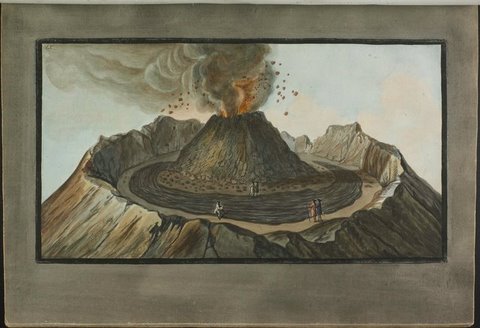The Campi Phlegraei is a first-hand report which documents the late eighteenth century eruptions of Mount Vesuvius. Written by Sir William Hamilton, the British envoy to the Neapolitan royal court in 1764, the work is named for the area around Naples known locally as the Campi Phlegraei or “flaming fields,” referring to the frequent and violent eruptions of Mount Vesuvius. The area was a popular destination for wealthy travelers undertaking the Grand Tour because of the long history of volcanic activity as well as the classical sites, Pompeii and Herculaneum, which were excavated in 1748 and 1738 respectively.

Hamilton was able to observe the volcano from his arrival in Naples on November 17, 1764, through the eruptions which lasted until October 20, 1767. He became a Fellow of the Royal Society and wrote a series of letters describing the activity of the volcano. The letters were to be read aloud at the Society’s meeting and published in its Transactions. The letters make up the text of the Campi Phlegraei. Hamilton engaged the Anglo-Neapolitan artist Peter Fabris to create sketches in situ to illustrate the work. The sketches were reproduced in prints that were hand colored individually by local artists.

Volume one of the Campi Phlegraei is predominately text with a single plate and a map. Volume two is predominantly plates with textual descriptions. The third book is a supplement to the original two volume work. The supplement was published in 1779 and describes the eruption of Mt. Vesuvius in August 1779. The supplement is composed of letters written to The Royal Society of London and five hand-colored plates illustrating the volcanic activity.
Special Collections copy of the Campi Phlegraei is part of the Woodford Collection of Geology, a collection of rare books, maps, and other materials collected by Pomona College geologist A. O. Woodford. The folio volumes were conserved in the 1990s, as they were in fragile condition, and can now be consulted in Special Collections by students and faculty in person, and in the Claremont Colleges Digital Library as a digital collection.